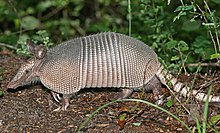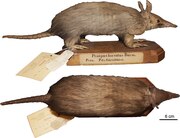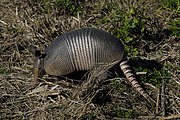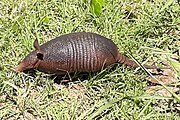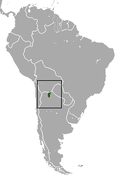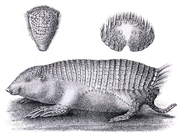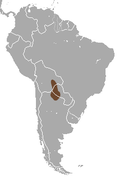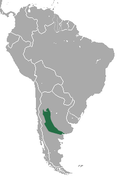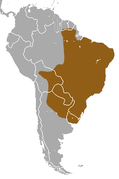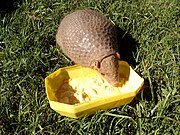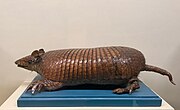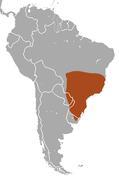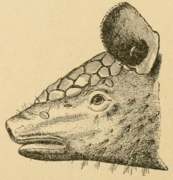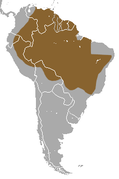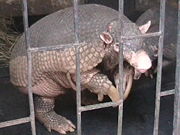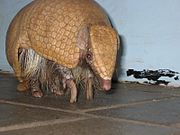Species in mammal order Cingulata
Nine-banded armadillo (Dasypus novemcinctus )Cingulata is an order of armored placental mammals . Members of this order are called cingulates, or colloquially, armadillos . They are primarily found in South America, though the northern naked-tailed armadillo is found mainly in Central America and the nine-banded armadillo has a range extending into North America. They are generally found in forests, but also savannas , shrublands , and grasslands . They all follow a similar body plan, and range in size from the pink fairy armadillo , at 11 cm (4 in) plus a 2 cm (1 in) tail, to the giant armadillo , at 100 cm (39 in) plus a 50 cm (20 in) tail. No population estimates have been made for any cingulate species, though the giant armadillo and the Brazilian three-banded armadillo are categorized as vulnerable species .
The twenty-two extant species of Cingulata are divided into two families : Dasypodidae , containing a single genus of nine species in the subfamily Dasypodinae, and Chlamyphoridae , containing thirteen species split between the two genera in the subfamily Chlamyphorinae , three in the subfamily Euphractinae , and three in the subfamily Tolypeutinae . Prior to 2016, all four subfamilies were included in Dasypodidae, with Chlamyphoridae containing only extinct species of glyptodonts .[ 1] [ 2] [ 3]
Conventions
Conservation status codes listed follow the International Union for Conservation of Nature (IUCN) Red List of Threatened Species . Range maps are provided wherever possible; if a range map is not available, a description of the cingulate's range is provided. Ranges are based on the IUCN Red List for that species unless otherwise noted. All extinct species or subspecies listed alongside extant species went extinct after 1500 CE, and are indicated by a dagger symbol "†".
Classification
The order Cingulata consists of two families , Dasypodidae and Chlamyphoridae . Dasypodidae contains nine species in a single genus , while Chlamyphoridae contains thirteen species in eight genera, divided into three subfamilies. Many of these species are further subdivided into subspecies. This does not include hybrid species or extinct prehistoric species.
Cingulates
The following classification is based on the taxonomy described by the reference work Mammal Species of the World molecular phylogenetic analysis .[ 4]
Dasypodidae
Subfamily Dasypodinae
Genus Dasypus Linnaeus , 1758
Common name
Scientific name and subspecies
Range
Size and ecology
IUCN status and estimated population
East Amazonian long-nosed armadillo
D. beniensis Lönnberg , 1942North-central South America
Size : 51–58 cm (20–23 in) long, plus 33–48 cm (13–19 in) tail[ 5] Habitat : Forest[ 6] Diet : Insects[ 5] NE [ 6]
Greater long-nosed armadillo
D. kappleri Krauss , 1862Northeastern South America
Size : 51–58 cm (20–23 in) long, plus 33–48 cm (13–19 in) tail[ 7] Habitat : Forest[ 6] Diet : Insects[ 7] LC [ 6]
Hairy long-nosed armadillo
D. pilosus (Fitzinger , 1856)
Western South America
Size : 32–44 cm (13–17 in) long, plus 23–31 cm (9–12 in) tail[ 8] Habitat : Forest[ 9] Diet : Insects[ 8] NE [ 9]
Llanos long-nosed armadillo
D. sabanicola Mondolfi , 1968Northern South America
Size : 25–31 cm (10–12 in) long, plus 17–21 cm (7–8 in) tail[ 10] Habitat : Forest[ 11] Diet : Termites, as well as ants, beetles, and worms[ 10] NT [ 11]
Nine-banded armadillo
D. novemcinctus Linnaeus , 1758
D. n. aequatorialis
D. n. fenestratus
D. n. hoplites
D. n. mexianae
D. n. mexicanus
D. n. novemcinctus
Central and northern South America, and central, southern, and eastern North America
Size : 35–57 cm (14–22 in) long, plus 24–45 cm (9–18 in) tail[ 12] Habitat : Forest, savanna , shrubland , and grassland [ 13] Diet : Omnivorous, including invertebrates, birds, fruit, and roots[ 12] LC [ 13]
Seven-banded armadillo
D. septemcinctus Linnaeus , 1758Eastern South America
Size : 24–31 cm (9–12 in) long, plus 12–17 cm (5–7 in) tail[ 14] Habitat : Forest, savanna, and grassland[ 15] Diet : Insects, seeds, and other plant material[ 14] LC [ 15]
Southern long-nosed armadillo
D. hybridus Desmarest , 1804Southeastern South America
Size : 26–31 cm (10–12 in) long, plus 15–19 cm (6–7 in) tail[ 16] Habitat : Forest, savanna, shrubland, and grassland[ 17] Diet : Ants, termites, and beetles, as well as plant material and small vertebrates[ 16] NT [ 17]
West Amazonian long-nosed armadillo
D. pastasae (Thomas , 1901)
Northwestern South America
Size : 51–58 cm (20–23 in) long, plus 33–48 cm (13–19 in) tail[ 18] Habitat : Forest[ 6] Diet : Insects[ 18] DD [ 6]
Yepes's mulita
D. mazzai Yepes , 1933South-central South America
Size : About 31 cm (12 in) long, plus 18–23 cm (7–9 in) tail[ 19] Habitat : Forest[ 20] Diet : Believed to be omnivorous with a preference for insects[ 19] DD [ 20]
Chlamyphoridae
Subfamily Chlamyphorinae
Genus Calyptophractus Fitzinger , 1871
Common name
Scientific name and subspecies
Range
Size and ecology
IUCN status and estimated population
Greater fairy armadillo
C. retusus (Burmeister , 1863)
Central South America
Size : 14–18 cm (6–7 in) long, plus 4 cm (2 in) tail[ 21] Habitat : Savanna, shrubland, and desert[ 22] Diet : Insects, worms, snails, roots, and small seeds[ 21] DD [ 22]
Genus Chlamyphorus Harlan , 1825
Common name
Scientific name and subspecies
Range
Size and ecology
IUCN status and estimated population
Pink fairy armadillo
C. truncatus Harlan , 1825Southern South America
Size : 11–15 cm (4–6 in) long, plus 2–3 cm (1–1 in)tail[ 23] [ 24] Habitat : Savanna, shrubland, grassland, and desert[ 25] Diet : insects, worms and snails, as well as possibly plants[ 23] DD [ 25]
Subfamily Euphractinae
Genus Chaetophractus Fitzinger , 1871
Common name
Scientific name and subspecies
Range
Size and ecology
IUCN status and estimated population
Big hairy armadillo
C. villosus (Desmarest , 1804)
Southern South America
Size : 22–40 cm (9–16 in) long, plus 9–17 cm (4–7 in) tail[ 12] Habitat : Forest, savanna, shrubland, grassland, and desert[ 26] Diet : Omnivorous, including insects, invertebrates, small vertebrates, plants, and carrion [ 27] LC [ 26]
Screaming hairy armadillo
C. vellerosus (Gray , 1865)
C. v. pannosus
C. v. vellerosus
Southern South America
Size : 20–30 cm (8–12 in) long, plus tail[ 28] Habitat : Savanna, shrubland, grassland, and desert[ 29] Diet : Beetles, butterfly larvae, plants, and small vertebrates[ 29] LC [ 29]
Genus Euphractus Wagler , 1830
Common name
Scientific name and subspecies
Range
Size and ecology
IUCN status and estimated population
Six-banded armadillo
E. sexcinctus (Linnaeus , 1758)
E. s. boliviae
E. s. flavimanus
E. s. setosus
E. s. sexcinctus
E. s. tucumanus
Central and eastern South America
Size : 40–50 cm (16–20 in) long, plus 20–25 cm (8–10 in) tail[ 30] Habitat : Forest, savanna, shrubland, and grassland[ 31] Diet : Carrion, small vertebrates, insects, spiders, bird eggs, and plants[ 30] LC [ 31]
Genus Zaedyus Ameghino , 1889
Common name
Scientific name and subspecies
Range
Size and ecology
IUCN status and estimated population
Pichi
Z. pichiy (Desmarest , 1804)
Z. p. caurinus
Z. p. pichiy
Southern South America
Size : 26–34 cm (10–13 in) long, plus 10–12 cm (4–5 in) tail[ 12] Habitat : Shrubland, grassland, and desert[ 32] Diet : Insects, worms, and other invertebrates, as well as carrion[ 12] NT [ 32]
Subfamily Tolypeutinae
Genus Cabassous McMurtrie , 1831
Common name
Scientific name and subspecies
Range
Size and ecology
IUCN status and estimated population
Chacoan naked-tailed armadillo
C. chacoensis Wetzel, 1980
South-central South America
Size : 30–35 cm (12–14 in) long, plus 9–10 cm (4–4 in) tail[ 33] Habitat : Forest, savanna, and shrubland[ 34] Diet : Ants and termites, as well as seeds and fruit[ 33] NT [ 34]
Greater naked-tailed armadillo
C. tatouay (Desmarest , 1804)
Eastern South America
Size : 36–49 cm (14–19 in) long, plus 15–20 cm (6–8 in) tail[ 35] Habitat : Forest and grassland[ 36] Diet : Ants and termites[ 37] LC [ 36]
Northern naked-tailed armadillo
C. centralis (Miller , 1899)
Northern South America and Central America
Size : 30–40 cm (12–16 in) long, plus 5–7 cm (2–3 in) tail[ 12] Habitat : Forest, savanna, and shrubland[ 38] Diet : Termites and ants[ 12] DD [ 38]
Southern naked-tailed armadillo
C. unicinctus (Linnaeus , 1758)
C. u. squamicaudis
C. u. unicinctus
Northern and central South America
Size : 35–44 cm (14–17 in) long, plus 16–20 cm (6–8 in) tail[ 39] Habitat : Forest, shrubland, and grassland[ 40] Diet : Ants and termites[ 39] LC [ 40]
Genus Priodontes F. Cuvier , 1825
Common name
Scientific name and subspecies
Range
Size and ecology
IUCN status and estimated population
Giant armadillo
P. maximus (Kerr , 1792)
Northern and central South America
Size : 75–100 cm (30–39 in) long, plus 50 cm (20 in) tail[ 41] Habitat : Forest, savanna, and grassland[ 42] Diet : Termites and certain ant species[ 43] VU [ 42]
Genus Tolypeutes Illiger , 1811
Common name
Scientific name and subspecies
Range
Size and ecology
IUCN status and estimated population
Brazilian three-banded armadillo
T. tricinctus (Linnaeus , 1758)
Eastern South America
Size : 23–25 cm (9–10 in) long, plus tail[ 44] Habitat : Savanna and shrubland[ 45] Diet : Ants, termites, beetles, and other insects, as well as plants[ 44] VU [ 45]
Southern three-banded armadillo
T. matacus (Desmarest , 1804)
South-central South America
Size : 20–25 cm (8–10 in) long, plus tail[ 46] Habitat : Savanna and shrubland[ 47] Diet : Insects, as well as fruit and seeds[ 46] NT [ 47]
References
^ Delsuc, F.; Gibb, G. C.; Kuch, M.; Billet, G.; Hautier, L.; Southon, J.; Rouillard, J.-M.; Fernicola, J. C.; Vizcaíno, S. F.; MacPhee, R. D. E.; Poinar, H. N. (2016). "The phylogenetic affinities of the extinct glyptodonts" . Current Biology 26 (4): R155 – R156 . doi :10.1016/j.cub.2016.01.039 hdl :11336/49579 PMID 26906483 . ^ Gibb, G. C.; Condamine, F. L.; Kuch, M.; Enk, J.; Moraes-Barros, N.; Superina, M.; Poinar, H. N.; Delsuc, F. (2015). "Shotgun Mitogenomics Provides a Reference PhyloGenetic Framework and Timescale for Living Xenarthrans" . Molecular Biology and Evolution 33 (3): 621– 642. doi :10.1093/molbev/msv250 . PMC 4760074 PMID 26556496 . ^ "Fossilworks: Cingulata" . Paleobiology Database University of Wisconsin–Madison . Retrieved November 27, 2021 .^ Wilson, Reeder , pp. 94–99^ a b "Greater long-nosed armadillo (Dasypus beniensis )" . Xenarthrans.org . IUCN/SSC Anteater, Sloth, and Armadillo Specialist Group. Retrieved November 29, 2021 .^ a b c d e f Anacleto, T. C. S.; Arteaga, M.; Superina, M.; Abba, A. M. (2014). "Dasypus kappleri " . IUCN Red List of Threatened Species 2014 : e.T6289A47440608. doi :10.2305/IUCN.UK.2014-1.RLTS.T6289A47440608.en ^ a b "Greater long-nosed armadillo (Dasypus kappleri )" . Xenarthrans.org . IUCN/SSC Anteater, Sloth, and Armadillo Specialist Group. Retrieved November 29, 2021 .^ a b "Hairy long-nosed armadillo (Dasypus pilosus )" . Xenarthrans.org . IUCN/SSC Anteater, Sloth, and Armadillo Specialist Group. Retrieved November 29, 2021 .^ a b Superina, M.; Abba, A. M. (2014). "Dasypus pilosus " . IUCN Red List of Threatened Species 2014 : e.T6291A47441122. doi :10.2305/IUCN.UK.2014-1.RLTS.T6291A47441122.en ^ a b "Northern long-nosed armadillo (Dasypus sabanicola )" . Xenarthrans.org . IUCN/SSC Anteater, Sloth, and Armadillo Specialist Group. Retrieved November 29, 2021 .^ a b Superina, M.; Trujillo, F.; Arteaga, M.; Abba, A. M. (2014). "Dasypus sabanicola " . IUCN Red List of Threatened Species 2014 : e.T6292A47441316. doi :10.2305/IUCN.UK.2014-1.RLTS.T6292A47441316.en ^ a b c d e f g Burnie , p. 111^ a b Loughry, J.; McDonough, C.; Abba, A. M. (2014). "Dasypus novemcinctus " . IUCN Red List of Threatened Species 2014 : e.T6290A47440785. doi :10.2305/IUCN.UK.2014-1.RLTS.T6290A47440785.en ^ a b "Seven-banded armadillo (Dasypus septemcinctus )" . Xenarthrans.org . IUCN/SSC Anteater, Sloth, and Armadillo Specialist Group. Retrieved November 29, 2021 .^ a b Anacleto, T. C. S.; Smith, P.; Abba, A. M.; Superina, M. (2014). "Dasypus septemcinctus " . IUCN Red List of Threatened Species 2014 : e.T6293A47441509. doi :10.2305/IUCN.UK.2014-1.RLTS.T6293A47441509.en ^ a b "Southern long-nosed armadillo (Dasypus hybridu )" . Xenarthrans.org . IUCN/SSC Anteater, Sloth, and Armadillo Specialist Group. Retrieved November 29, 2021 .^ a b Abba, A. M.; Gonzalez, E. (2014). "Dasypus hybridus " . IUCN Red List of Threatened Species 2014 : e.T6288A47440329. doi :10.2305/IUCN.UK.2014-1.RLTS.T6288A47440329.en ^ a b "Greater long-nosed armadillo (Dasypus pastasae )" . Xenarthrans.org . IUCN/SSC Anteater, Sloth, and Armadillo Specialist Group. Retrieved November 29, 2021 .^ a b "Yungas lesser long-nosed armadillo (Dasypus mazzai )" . Xenarthrans.org . IUCN/SSC Anteater, Sloth, and Armadillo Specialist Group. Retrieved November 29, 2021 .^ a b Abba, A. M.; Vizcaíno, S. (2014). "Dasypus yepesi " . IUCN Red List of Threatened Species 2014 : e.T61924A47444043. doi :10.2305/IUCN.UK.2014-1.RLTS.T61924A47444043.en ^ a b Gonsiorowski, Elizabeth (2002). "Calyptophractus retusus " . Animal Diversity Web University of Michigan . Retrieved November 23, 2021 . ^ a b Cuellar, E.; Meritt, D. A.; Delsuc, F.; Superina, M.; Abba, A. M. (2014). "Calyptophractus retusus " . IUCN Red List of Threatened Species 2014 : e.T4703A47439036. doi :10.2305/IUCN.UK.2014-1.RLTS.T4703A47439036.en ^ a b "Pink fairy armadillo (Chlamyphorus truncatus )" . Xenarthrans.org . IUCN/SSC Anteater, Sloth, and Armadillo Specialist Group. Retrieved November 30, 2021 .^ Carwardine , p. 68^ a b Superina, M.; Abba, A. M.; Roig, V. G. (2014). "Chlamyphorus truncatus " . IUCN Red List of Threatened Species 2014 : e.T4704A47439264. doi :10.2305/IUCN.UK.2014-1.RLTS.T4704A47439264.en ^ a b Abba, A. M.; Poljak, S.; Superina, M. (2014). "Chaetophractus villosus " . IUCN Red List of Threatened Species 2014 : e.T4369A47438745. doi :10.2305/IUCN.UK.2014-1.RLTS.T4369A47438745.en ^ Abbott, Sarah (2002). "Chaetophractus villosus " . Animal Diversity Web University of Michigan . Retrieved November 23, 2021 . ^ "Screaming hairy armadillo (Chaetophractus vellerosus )" . Xenarthrans.org . IUCN/SSC Anteater, Sloth, and Armadillo Specialist Group. Retrieved November 30, 2021 .^ a b c IUCN SSC Anteater, Sloth and Armadillo Specialist Group. (2017) [amended version of 2016 assessment]. "Chaetophractus vellerosus " . IUCN Red List of Threatened Species 2017 : e.T89604632A119877197. doi :10.2305/IUCN.UK.2017-3.RLTS.T89604632A119877197.en ^ a b "Six-banded armadillo (Euphractus sexcinctus )" . Xenarthrans.org . IUCN/SSC Anteater, Sloth, and Armadillo Specialist Group. Retrieved November 30, 2021 .^ a b Abba, A. M.; Lima, E.; Superina, M. (2014). "Euphractus sexcinctus " . IUCN Red List of Threatened Species 2014 : e.T8306A47441708. doi :10.2305/IUCN.UK.2014-1.RLTS.T8306A47441708.en ^ a b Superina, M.; Abba, A. M. (2014). "Zaedyus pichiy " . IUCN Red List of Threatened Species 2014 : e.T23178A47443734. doi :10.2305/IUCN.UK.2014-1.RLTS.T23178A47443734.en ^ a b "Chacoan naked-tailed armadillo (Cabassous chacoensis )" . Xenarthrans.org . IUCN/SSC Anteater, Sloth, and Armadillo Specialist Group. Retrieved December 2, 2021 .^ a b Meritt, D. A.; Superina, M.; Abba, A. M. (2014). "Cabassous chacoensis " . IUCN Red List of Threatened Species 2014 : e.T3413A47437534. doi :10.2305/IUCN.UK.2014-1.RLTS.T3413A47437534.en ^ "Greater naked-tailed armadillo (Cabassous tatouay )" . Xenarthrans.org . IUCN/SSC Anteater, Sloth, and Armadillo Specialist Group. Retrieved December 2, 2021 .^ a b Gonzalez, E.; Abba, A. M. (2014). "Cabassous tatouay " . IUCN Red List of Threatened Species 2014 : e.T3414A47437737. doi :10.2305/IUCN.UK.2014-1.RLTS.T3414A47437737.en ^ Zajic, Lara (2006). "Cabassous tatouay " . Animal Diversity Web University of Michigan . Retrieved November 23, 2021 . ^ a b Tirira, D. G.; Díaz-N., J.; Superina, M.; Abba, A. M. (2014). "Cabassous centralis " . IUCN Red List of Threatened Species 2014 : e.T3412A47437304. doi :10.2305/IUCN.UK.2014-1.RLTS.T3412A47437304.en ^ a b "Southern naked-tailed armadillo (Cabassous unicinctus )" . Xenarthrans.org . IUCN/SSC Anteater, Sloth, and Armadillo Specialist Group. Retrieved December 2, 2021 .^ a b Anacleto, T. C. S.; Moraes Tomas, W.; Superina, M. (2014). "Cabassous unicinctus " . IUCN Red List of Threatened Species 2014 : e.T3415A47437949. doi :10.2305/IUCN.UK.2014-1.RLTS.T3415A47437949.en ^ Burnie , p. 110^ a b Anacleto, T. C. S.; Miranda, F.; Medri, I.; Cuellar, E.; Abba, A. M.; Superina, M. (2014). "Priodontes maximus " . IUCN Red List of Threatened Species 2014 : e.T18144A47442343. doi :10.2305/IUCN.UK.2014-1.RLTS.T18144A47442343.en ^ Armitage, David (2004). "Priodontes maximus " . Animal Diversity Web University of Michigan . Retrieved November 23, 2021 . ^ a b "Brazilian three-banded armadillo (Tolypeutes tricinctus )" . Xenarthrans.org . IUCN/SSC Anteater, Sloth, and Armadillo Specialist Group. Retrieved December 2, 2021 .^ a b Miranda, F.; Moraes-Barros, N.; Superina, M.; Abba, A. M. (2014). "Tolypeutes tricinctus " . IUCN Red List of Threatened Species 2014 : e.T21975A47443455. doi :10.2305/IUCN.UK.2014-1.RLTS.T21975A47443455.en ^ a b "Southern three-banded armadillo (Tolypeutes matacus )" . Xenarthrans.org . IUCN/SSC Anteater, Sloth, and Armadillo Specialist Group. Retrieved December 2, 2021 .^ a b Noss, A.; Superina, M.; Abba, A. M. (2014). "Tolypeutes matacus " . IUCN Red List of Threatened Species 2014 : e.T21974A47443233. doi :10.2305/IUCN.UK.2014-1.RLTS.T21974A47443233.en
Sources
